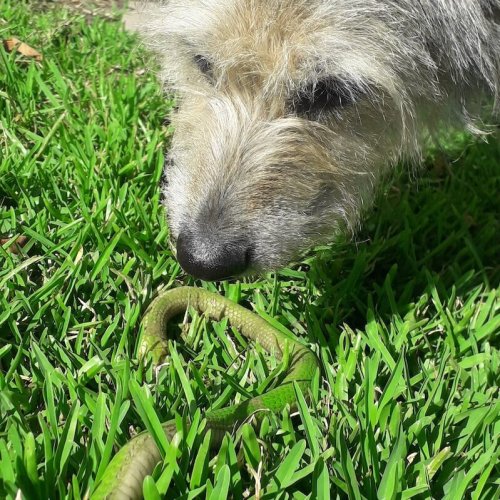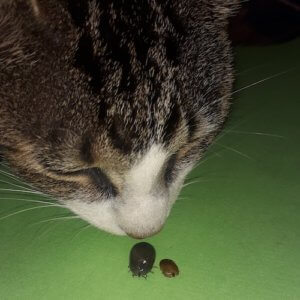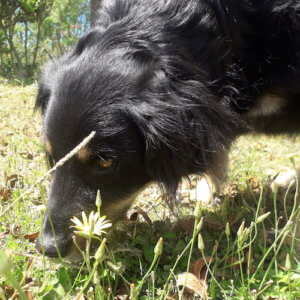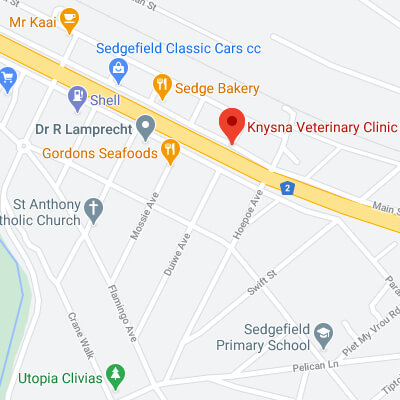It’s the thought that scares me the most while running on trails through the bush… a snake bite! Not for myself (well, maybe a little), but for my loyal 4-footed running buddy, Chewy, who never leaves my side. This is a fear that most South African pet owners can thoroughly identify with.

Snakes are elusive and shy creatures. They are more scared of you than you (or your pet!) are of them. Striking and making venom use precious resources. They don’t really want to waste that on you or your fluffy trail buddy. They strike out in defence when they feel threatened or are taken by surprise.
Nevertheless… their venom can harm or even kill your pet.
In this post, we are going to look at:
- the three most common venomous snakes in our beautiful Garden Route area;
- the type of venom they each have, and the effects of the venom;
- what you (and we) can do to save your pet if they get bitten.
Puff adders

Puff adder
Puff adder bites are by far the most common snake bites we see here at our practice. Puffies are identified as thick, “stocky” snakes, with chevron signs all along their backs. They are relatively short and rarely grow longer than 1 metre. They like to sunbathe, and your nosey pooch might want to investigate and stick their nose right up against these sneaky reptiles. This is because puff adders can “scent camouflage” (by means of chemical crypsis), which means that your pooch, who can normally win the world record for sniffing out a scent, can see them but not smell them. That messes with their brain!
Watch out for: exceptionally hot days in the middle of winter. On days like this, puffies crawl out for some warmth, but are still too sluggish and slow to get out of harm’s way and hide.
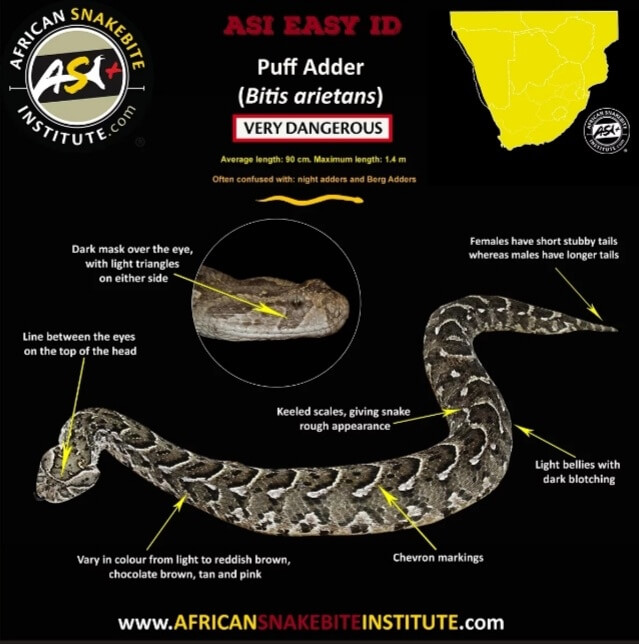
Puffadder venom causes severe pain and damage
Puff adders produce cytotoxic venom. This type of venom kills body tissue cells, and the bitten area becomes severely swollen. If your pet is bitten in the face or around the neck, even massive swelling may cause only a little tissue damage because of the large “loose” space under the skin. On the other hand, the skin around the legs are tighter with very little room under the skin to allow for excessive swelling. Therefore, if bitten on the leg, the pressure of the swelling can cause the skin to go necrotic and die, leaving a very nasty wound that struggles to heal.
Symptoms of a puff adder bite include:
- bleeding and bruising at the site of the bite
- a severe shock reaction, with blood vessels dilating and blood pressure dropping
- collapse
- and sadly, even death.
If your pet survives the poison, swelling and tissue necrosis (cell death), your pets’ kidneys might still be in danger. The breakdown products of the dead muscle cells often become too much for the kidneys’ filtration system to handle, and your pet could end up with kidney failure.
How to save your pet after a puffy bite
If you suspect your dog was bitten by a puff adder, get him or her to your vet as soon as possible. Carry your pet to the car if this is possible, to reduce the spread of the snake venom. Do not attempt any first aid at home, as this will only delay necessary treatment and may ultimately cause more harm than good.
Here’s how vets treat puff adder bites:
- A basic, quick clinical examination is performed.
- We might put your pet on a drip and slowly administer an antivenom to counteract the toxin.
- A painkiller may also be given.
- If we suspect an allergic reaction to the toxin and your pet is having breathing difficulties, a cortisone injection and anti-histamines might be given.
We do not generally give antibiotics for snake bites, unless there is evidence of a bacterial infection at the wound.
Anti-venom neutralises a fixed amount of venom, so regardless of the size of your pet, the same amount of anti-venom can be given. Sadly, it is very expensive, so this is the limiting factor of how much you can give. We typically give one to three vials and then reassess the pet’s clinical signs.
The swelling generally takes a few days to go down.
A quick word on night adders

Night adder
Night adders also carry a cytotoxic toxin, but it is much less venomous than a puffadder’s. There is no anti-venom against night adder bites. Most night adder bite victims do not need any treatment, but the rare cases that do are treated with the same procedure that we use for puff adder bites – we just exclude the anti-venom.
Boomslangs
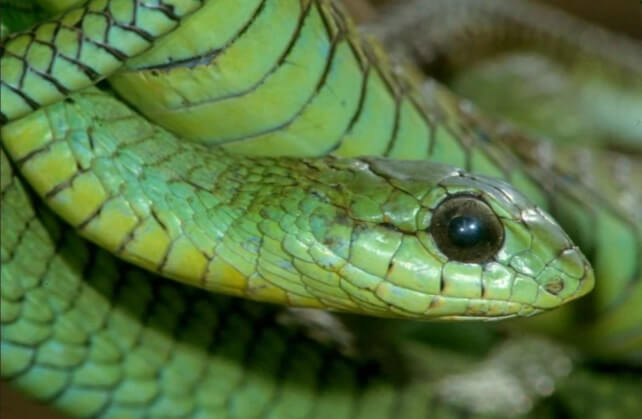
Photo credit: https://www.africansnakebiteinstitute.com/snake/boomslang/
Boomslangs are very shy reptiles. They are slender snakes that can grow very long – sometimes even up to 2 metres. They wear a variety of colours: females are often olive brown, while the males can be green or black. They are identified by their large eyes and short snout.
As their name suggests, they are often found in trees. They are hard to spot because their colouring is highly effective at camouflaging them among the foliage.
Fortunately, boomslang bites are fairly uncommon. However, they are really deadly, so it’s crucial to know what to do if your furry friend gets bitten.
Boomslang venom has a dramatic effect on the blood cells
Boomslangs produce hemotoxic venom. This type of venom uses up all the victim’s blood clotting factors and cells (“consumption coagulopathy”), causing widespread blood clotting. The result is excessive, uncontrollable haemorrhage or bleeding.
How to save your pet after a boomslang bite
If you suspect your dog was bitten by a boomslang, get him to your vet as soon as possible. As in the case of puff adder bites, do not attempt any first aid at home, as this will only delay the necessary treatment and cause more harm than good.
The only thing that can save your pet’s life if he or she suffered a potentially lethal boomslang bite is anti-venom. Unfortunately, due to the fact that boomslang bites are so infrequent, most veterinary practices do not stock the anti-venom. It might take quite a few hours to have the anti-venom couriered to the clinic.
Here’s how we treat boomslang bites:
- A basic, quick clinical evaluation is performed.
- We order antivenom via an emergency courier.
- In the meantime, blood transfusion can be life-saving, replacing the cells necessary for normal blood clotting.
As with puffy bites, prompt action can be the difference between life and death.
Cape cobras (geelslang)
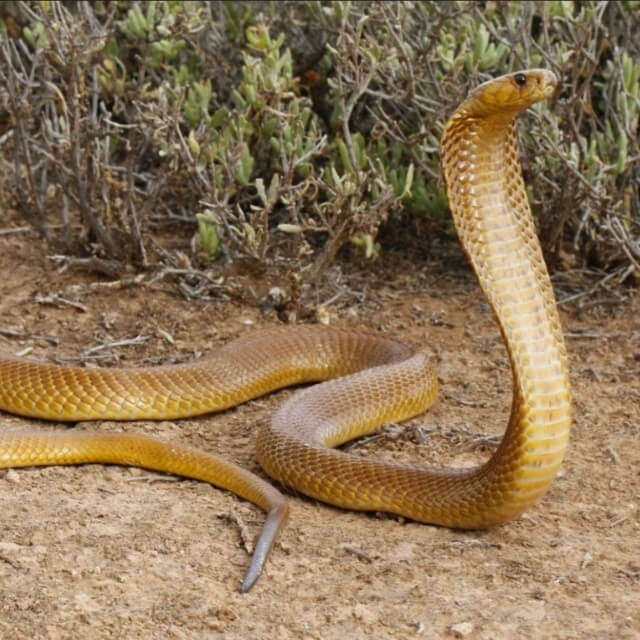
Photo credit: https://www.africansnakebiteinstitute.com/snake/cape-cobra/
Fortunately, in our area, Cape cobras are a rare sight. They are around, but luckily in our clinic we have thus far never had to experience fighting for a patient’s life after a geelslang bite.
Cape cobras can vary in colour, ranging from rich yellow to golden brown, dark brown or even darker. They may have black or pale blotches on their skin. They have broad heads that flare out into the typical cobra hoods when agitated or ready to strike. They are large snakes – fully grown adults can measure up to 1.6 metres in length.
Geelslang venom acts very quickly.
The Cape cobra’s venom is neurotoxic. It paralyses the nervous system, and the victim dies due to paralysis of the breathing muscles. This can happen in as little as 30 minutes after the bite.
Is it possible to save your pet after a Cape cobra bite?
A Cape cobra bite is nearly 100% lethal. Not many dogs survive this toxin. It is unlikely that you will make it to your vet in time, but getting there as soon as possible is your pet’s best chance.
Here’s how your vet may attempt to treat this bite:
- As with the other bites, a quick clinical evaluation will be performed.
- Administering the anti-venom as soon as possible is critical. Cape cobra anti-venom is included in the polyvalent anti-venom used for some other snake bites like the puff adder, so it’s usually on hand.
- Your pet will also need to go on a ventilator if they are unable to breath by themselves. A ventilator is not something every vet practice has, which means that your pet will most likely have to be hospitalised in a referral hospital to survive.
Sadly, the mortality rate is very high despite the best of ICU care.
Prevention is the best medicine
Snakes are common in our country, particularly during the sunny summer months. If you love to range through the bush with your pet, it’s impossible to guarantee that you’ll never come across a venomous snake, but there are some very effective actions you can take to make sure your snake encounter doesn’t turn into a frantic trip to the vets.
Here are my top tips for preventing snake bites.
- Learn to identify the common venomous snakes in your area.
- Train your dog to come to your side on command.
- Keep your dog on a leash when you’re walking on trails (boring, I know, but an especially good idea in summer).
- Stick to open paths where you can see what is ahead.
In conclusion
That was a big bite! Despite the harm these venomous snake bites can cause, snakes are an essential, integral part of a healthy ecosystem in our area. They play a big part in keeping pests and rodents in check.
If you do find yourself staring down a venomous snake in your garden, please drop that spade and put murderous thoughts aside. We have heroes in our midst that will come and relocate them to a safer area for free – namely, the Sedgefield Fire Brigade. Here are their numbers (you might want to stick these on the fridge):
- Landline: 044 302 8911
- On duty cell phone nr.: 0609987117 (in case the landline is not responding)
The following website has more useful information on the identification of snake species and treatment of bites: https://www.africansnakebiteinstitute.com/app/
Best of luck this summer as you enjoy the beautiful nature here in the Garden Route!


